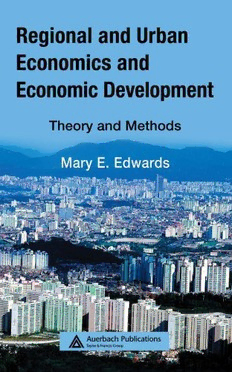
Regional and Urban Economics and Economic Development : Theory and Methods PDF
Preview Regional and Urban Economics and Economic Development : Theory and Methods
AU8317—Prelims—27/1/2007—09:40—BSARAVANAN—220204—XMLMODELC–pp.1–33 AU8317—Prelims—27/1/2007—09:41—BSARAVANAN—220204—XMLMODELC–pp.1–33 CRC Press Taylor & Francis Group 6000 Broken Sound Parkway NW, Suite 300 Boca Raton, FL 33487-2742 © 2007 by Taylor & Francis Group, LLC CRC Press is an imprint of Taylor & Francis Group, an Informa business No claim to original U.S. Government works Version Date: 20110715 International Standard Book Number-13: 978-0-8493-8318-2 (eBook - PDF) This book contains information obtained from authentic and highly regarded sources. Reasonable efforts have been made to publish reliable data and information, but the author and publisher cannot assume responsibility for the validity of all materials or the consequences of their use. The authors and publishers have attempted to trace the copyright holders of all material reproduced in this publication and apologize to copyright holders if permission to publish in this form has not been obtained. If any copyright material has not been acknowledged please write and let us know so we may rectify in any future reprint. Except as permitted under U.S. Copyright Law, no part of this book may be reprinted, reproduced, transmitted, or utilized in any form by any electronic, mechanical, or other means, now known or hereafter invented, including photocopying, microfilming, and recording, or in any information stor- age or retrieval system, without written permission from the publishers. For permission to photocopy or use material electronically from this work, please access www.copy- right.com (http://www.copyright.com/) or contact the Copyright Clearance Center, Inc. (CCC), 222 Rosewood Drive, Danvers, MA 01923, 978-750-8400. CCC is a not-for-profit organization that pro- vides licenses and registration for a variety of users. For organizations that have been granted a pho- tocopy license by the CCC, a separate system of payment has been arranged. Trademark Notice: Product or corporate names may be trademarks or registered trademarks, and are used only for identification and explanation without intent to infringe. Visit the Taylor & Francis Web site at http://www.taylorandfrancis.com and the CRC Press Web site at http://www.crcpress.com Dedication To my husband, Chester AU8317—Prelims—27/1/2007—09:42—BSARAVANAN—220204—XMLMODELC–pp.1–33 Foreword Abasic principle amonggeographers is that everythingis somewhere,and where it is matters. Far from being random, the spatial distribution of phenomena over the earth’s surface has causes, and it also has effects. An important part of both causes and effects relates to cost, or in other words, economicfactors.Regionalandurbaneconomicsexplorethesecost-related causes and effects of the location of many kinds of phenomena. Understandingtheseeconomicfactorshasimportantpracticaluses,both in personal lives and in the establishment of public policy. Regional and Urban Economics: Theory and Methods addresses these topics from both points of view. People make many decisions in their lives, even uncon- sciously,onthebasisofrelativecosts.Particularlyinthesedaysofhighand risingfuelprices,howfarawayapotentialdestinationiscangreatlyimpact its attractiveness. Similarly, business firms must locate their facilities some- where.Theinputsneededandthemarketarealsolocatedsomewhere,and firms must somehow bring those factors together or bridge the gaps betweenthem.Thus,theyfacetransportationexpenses—thecostofrelative locations—andfactortheseexpensesintolocationdecisions.Theirchoices will, in turn, influence other locational decisions. Publicpolicydecisionsareamajorfactorinlocationaldecision-making. They involve the siting of public facilities, which in turn may make a particular location more or less attractive to enterprises. Firms bring jobs andpurchasegoodsandserviceslocally,therebyinfluencinghowattractive theregionistopeople.Inotherwords,attractingfirmstoaregionisakeyto its economic development, raising the standard of living for residents. These principles also apply to urban areas, where the vast majority of North Americans live. Periurban zones, those rural areas that border cities, have been especially attractive to Americans, leading to greater wealth but alsotothespreadofurbanfeaturesthathavebeendubbed“sprawl.”Issues ofhousingaffordability,lossofgreenspace,andincreasedtrafficcongestion AU8317—Prelims—27/1/2007—09:42—BSARAVANAN—220204—XMLMODELC–pp.1–33 viii & havebeen particularlycontroversial,leading tovariousproposals andcalls for“sustainable”or“smart”growthofcities.Economicsfacestheemotional component of these issues with hard analysis, which brings new perspec- tives even though it may not have final answers. The issue becomes political, and in such policy disputes, economics offers a less emotional perspective. It also introduces the spatial perspective of impacts on neighboringplaces,asonejurisdictionconsidersaparticularpolicyalterna- tivethatmayseemespeciallyattractiveforitsresidentsbutmayexacerbate problems elsewhere in the wider region. Urbaneconomicsalsoaddresseslocationalquestionsofpublicfacilities, especially as cities attempt to deal with problems that concentrated there, such as poverty and crime. Cities contain diverse populations that contend forresources,andmunicipalgovernmentsfacethechallengeofanequitable distribution of costs and benefits. Regional and Urban Economics: Theory and Methods introduces students to these principles that will impact their lives. They make daily decisions as consumers and as residents, and the book regularly invites them to consider these questions. Furthermore, if only as voters, they participate in collective decisions on various questions of public policy, including the all-important issue of where. Where it is matters in terms of economic causes and effects. Elizabeth J. Leppman Lexington, Kentucky AU8317—Prelims—27/1/2007—09:42—BSARAVANAN—220204—XMLMODELC–pp.1–33 Preface Thisbookprovidesasolidapproachtoanalyzingtheeconomyofaregion or urban area. The aim is to first study firm location analysis and then to investigate why regions grow. Once regional growth is understood, it is possible to envision how growth affects the various-sized cities within an area and the use of land in and around its cities. After determining where households will locate, it is then possible to analyze the effectiveness of local governments in solving problems endemic to an urban area. It is important for students to have hands-on experience in evaluating regionaldata.Providedarestraightforwarddirectionsfordelineatingmarket areas, for identifying the economic base of a region, and for decomposing regionalemploymentdatatodeterminewhyitisexpandingorcontracting. This text also describes methods for calculating and interpreting various indicatorsofsocialwelfare,suchasstandard-of-livingindices,dependency ratios, employment and unemployment indicators, inequality indices, and migration rates. Finally, herein lies a framework for evaluating public policy based on efficiency and equity concerns. This framework uses analyses based on traditional public finance models as well as on public choice models. Several definitions of “equity” are investigated, and these definitions are incorporated throughout the text in the policy analyses. Intended Audience The audience of this textbook includes students of economics, real estate, public administration, and economic development. It is assumed that students have studied principles of macroeconomics and microeconomics. The book is accessible to students whose understanding of economics is limited; however, techniques unique to regional analysis will also interest advanced undergraduate students and master’s degree students of economics. AU8317—Prelims—27/1/2007—09:42—BSARAVANAN—220204—XMLMODELC–pp.1–33
